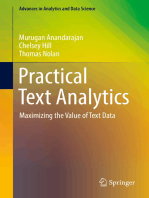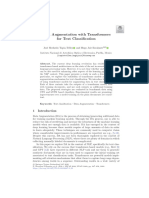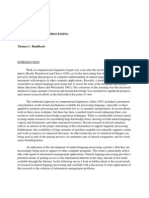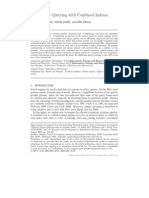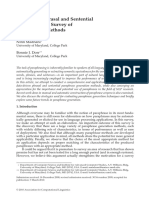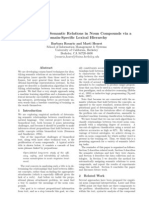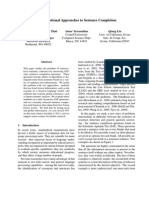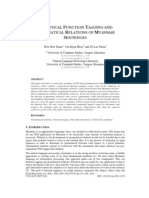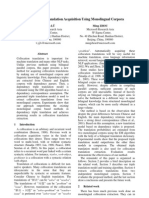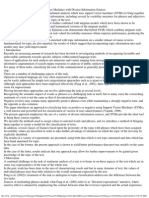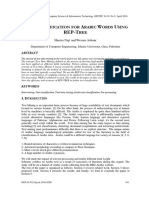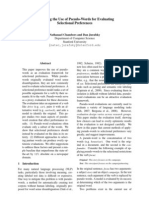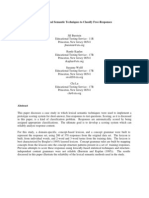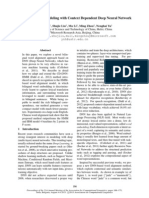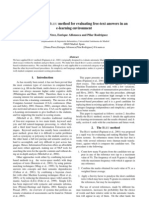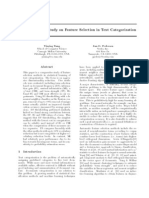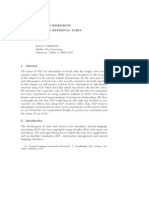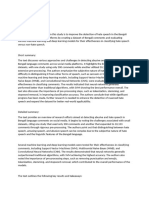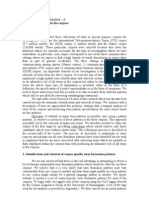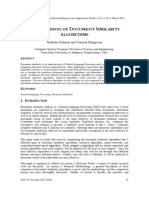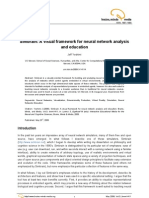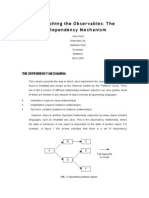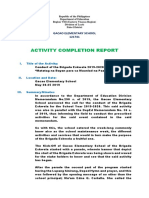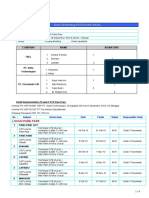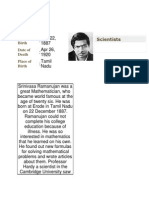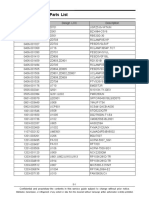The Use of Bigrams To Enhance Text Categorization
The Use of Bigrams To Enhance Text Categorization
Uploaded by
Caterina CarboneCopyright:
Available Formats
The Use of Bigrams To Enhance Text Categorization
The Use of Bigrams To Enhance Text Categorization
Uploaded by
Caterina CarboneOriginal Description:
Original Title
Copyright
Available Formats
Share this document
Did you find this document useful?
Is this content inappropriate?
Copyright:
Available Formats
The Use of Bigrams To Enhance Text Categorization
The Use of Bigrams To Enhance Text Categorization
Uploaded by
Caterina CarboneCopyright:
Available Formats
The Use of Bigrams to Enhance
Text Categorization
Chade-Meng Tan
*
Yuan-Fang Wang
**
Chan-Do Lee
Department of Computer Science
University of California
Santa Barbara, CA 93106
Tel: (805)893-3866
FAX: (805)893-8553
meng@google.com yfwang@cs.ucsb.edu
Department of Information and
Communication Engineering
Taejon University
Taejon, 300-716, KOREA
Tel: 82(42)280-2551
FAX: 82(42)284-0109
cdlee@dragon.taejon.ac.kr
*
Current Address: Google Inc., 2400 Bayshore Pkwy, Mountain View, CA 94043.
Tel: (650)330-0100 x 1146; FAX: (650)618-1499
**
Corresponding author
1
Abstract
In this paper, we present an efficient text categorization algorithm that generates bigrams
selectively by looking for ones that have an especially good chance of being useful. The
algorithm uses the information gain metric, combined with various frequency thresholds. The
bigrams, along with unigrams, are then given as features to two different classifiers: Nave Bayes
and maximum entropy. The experimental results suggest that the bigrams can substantially raise
the quality of feature sets, showing increases in the break-even points and F1 measures. The
McNemar test shows that in most categories the increases are very significant. Upon close
examination of the algorithm, we concluded that the algorithm is most successful in correctly
classifying more positive documents, but may cause more negative documents to be classified
incorrectly.
Keywords: information retrieval, text categorization, text classification, machines learning.
2
1. Introduction
Text categorization (also known as text classification) is, quite simply, the automated
assignment of natural language texts to predefined categories based on their content (see
Sebastiani, 2000, for an introduction). Its applications include indexing texts to support
document retrieval, extracting data from texts, and aiding humans in these tasks (Lewis 1992b).
The performance of standard text categorization techniques on standard test corpora has been
quite encouraging. Apt et al. (1998), for example, reported an 87.8% precision/recall break-
even point for the Reuters-21578 corpus.
At present, text categorization techniques are predominantly keyword-based. Many
researchers in the field have used different classifiers, but most of them treat a document as a bag
of words (BOW), that is, identify terms with all the words occurring in the document, and
perform categorizations based mainly on the presence or absence of keywords. Billsus and
Pazzani (1997) showed that various categorization techniques produced similar results for BOW-
based features
1
. Yang and Pederson (1997) and Lewis and Ringuette (1994) came to the s imilar
conclusions.
1
In categorization features are often used to refer to the same kind of entity as terms in
information retrieval. In this paper, we use them interchangeably as appropriate.
3
In a number of experiments (Lewis, 1992a, 1992b, 1992c; Apt et al., 1994), it was found
that the use of phrases
2
actually cause d text categorization performance to degrade. Despite of
these discouraging results, investigations of using phrases have been actively pursued (Mladeni)
and Grobelnik 1998; Frnkranz, 1998; Schtze et al., 1995; Schapire et al., 1998).
This paper presents our attempt to improve categorization performance by automatically
extracting and using phrases, especially two-word phrases (hereafter bigrams). Our algorithm
generates high quality bigrams by using the information gain (infogain) metric, combined by
various frequency thresholds. The experimental results suggest that the bigrams can substantially
raise the quality of feature sets, showing increases in the break-even points and F1 measures.
The remainder of the paper is organized as follows: Section 2 reviews related works and
justifies our study, Section 3 discusses our algorithm and its implementation, Section 4 presents
our experimental results, Section 5 analyzes the results and the performance of the algorithm,
and Section 6 suggests further work.
2
A phrase refers to an indexing term that corresponds to the presence of two or more single
word indexing terms (Lewis, 1992a, p.35), whether the notion of phrase is motivated
syntactically or statistically.
4
2. The Use of Phrases in Text Categorization
Lewis (1992a, 1992b, 1992c) extensively examined the use of phrases in text
categorization. He performed part-of-speech parsing on the text and used all noun phrases that
occurred at least twice as features. He showed that phrases gave worse performance than single
words. The degradation in performance was due to that high dimensionality, low frequency, and
high degree of synonymy using phrases as features outweigh the advantages phrases had in
lowering ambiguity (Lewis 1992b). Lewis (1992a) gave a more detailed analysis of why phrases
failed to do well. He stated 6 characteristics that were desirable for features for text
categorization:
1. Small number of indexing terms
2. Flat distribution of values for an indexing term
3. Lack of redundancy among terms
4. Low noise in indexing term values
5. Lack of ambiguity for linguistically derived terms
6. Terms should be related to the classes to be induced
Phrases tend to do well on the criterion 5, but badly on the first 4 criteria. First, the
number of indexing terms for phrases may be large. If there are d words, for example, there are
potentially d
2
phrases. Second, most of these d
2
phrases are likely to take on the value of 0 for all
documents, while the rest might be 0 for most documents, implying that the distribution of the
indexing terms may be far from flat. Third, phrases are likely to have higher redundancy caused
5
by high synonymy: if each word in a phrase has k synonyms, then k
2
phrases could have the
same meaning. Lastly, phrases tend to be noisier. If two phrases have an identical meaning, we
would want them to be assigned to the same documents. However, in most natural language
texts, the opposite is the case. In short texts, there are simply not enough references to a concept
for all the synonymous phrases to be used. Having more phrases with the same meaning only
worsens the problem.
Several efforts have been made to circumvent the possible problems posed by using
phrases and some research results showed that the addition of n-grams (sequences of words of
length n) to the BOW representation indeed improved performance. However, sequences of
length n > 3 were shown to be not useful and might decrease the performance.
Mladeni) and Grobelnik (1998) generated new features based on word sequences of
different length up to 5. Learning was performed using Nave Bayes (NB) classifier on feature-
vectors, where only highly scored features according to term frequency were used. The
performance was evaluated using Yahoo text hierarchy. They showed that using word sequences
of length up to 3 instead of using only single words improved the performance, while longer
sequences in average had no influence on the performance.
Frnkranz (1998) came to a similar conclusion. He used an algorithm based on the
APRIORI algorithm for efficiently generating features using term frequency and document
frequency as criteria. His experimental results indicated that word sequences of length 2 or 3
were most useful, while using longer sequences reduced categorization performance. He also
6
showed that moderate frequency-based pruning of the feature set could be useful, while heavy
frequency-based pruning resulted in a performance decrease, thus contradicting the findings by
Yang and Pederson (1997) and Lewis (1992b) that heavy pruning may improve performance.
Schtze et al. (1995) applied dimensionality reduction techniques to overcome
computational intensity and overfitting in solving document routing, a problem of statistical text
categorization. As terms they used single words and two-word phrases that were chosen by term
frequency as an evaluation measure. Their findings showed that a reduced feature space was both
practical and beneficial for document routing.
Schapire et al. (1998) used words and phrases in applying Rocchios algorithm for text
filtering. They also used term frequency as a criterion to choose which phrases to select.
However, they were not clear as to what a phrase meant.
Jensen and Martinez (2000) used conceptual and contextual features, such as synonyms,
hypernyms, and bigrams, to improve text classification. Multiple permutations of the features
were applied to three classification models (coordinate matching, TF*IDF, and NB) over three
data sets (Reuters, USENET, and folk songs). They reported that introducing those features
decreased the error by as much as 33%. However, the details of bigram extractions were not
given.
Our approach is different in many aspects from the above-mentioned studies. First, we
use bigrams in addition to, not in place of, single words. Second, we are highly selective of the
bigrams we use. The number of bigrams our algorithm finds is no more than 2% of the number
7
of single words as we try to avoid the problem of high dimensionality. With continued use of
single words in combination with a small number of added bigrams, our approach fares only
slightly worse for criteria 1 4 mentioned in Lewis (1992a). Finally, we use infogain in addition
to document frequency and term frequency to choose which bigrams to use. This means that the
bigrams that we select are likely to be good discriminators and less likely to be noisy.
3. Our Algorithm and Its Implementation
The idea of our algorithm is simply to find bigrams in which at least one of the
constituent words (hereafter unigrams) has a minimum document frequency in at least one of the
categories. Intuitively, what our algorithm does is to first find the list of unigrams that appear in
a significant number of documents, and use them as seeds. All the training documents are then
scanned and we gather all bigrams where at least one of its component unigrams is a seed. We
then select only the bigrams, among those extracted, with high occurrences and infogain. Figure
1 shows the pseudo-code of our algorithm.
8
1. Find S = {set of words that occur in at least df_seed * number of documents in at least 1 category }
2. Set B = @.
3. For each document in the training set
4. {
5. Preprocess document by removing all numbers, punctuation and words in a stoplist.
6. For each pair of adjacent words (w1, w2) in preprocessed document
7. If (w1 is in S or w2 is in S), add bigram "w1+w2" to B.
8. }
9. For each b in B
10. {
11. For each category c
12. {
13. If (b occurs in less than df_bigram * number of documents in category c)
14. OR (b occurs in fewer than tf_bigram times in all documents)
15. remove b from B
16. }
17. If (b is not removed and b has infogain < ig_bigram) remove b from B
18. }
19. Output B
Figure 1. Bigram extraction algorithm
We performed some pilot experiments and the number 0.01 seemed to be good for
df_seed, 0.005 for df_bigram, and 3 for tf_bigram. For ig_bigram, we set it to the infogain of the
single word at position igat_unigram in the list of unigrams sorted by decreasing infogain.
igat_unigram was set at approximately 1 percent of all unigrams. We also set max_bigram at 1.5
times igat_unigram. In our experiments, igat_unigram was set to 1500 for the Yahoo! Science
corpus (corresponding roughly to 1% of the 160,000+ unique unigrams) and for the Reuters
corpus, it was set to 400 (about 1% of the 42,000+ unique unigrams).
The algorithm employs the inclusive lexical analyzer. Our pilot study (Tan, 2000) let
lexical analyzer process bigrams in an exclusive fashion: I.e., if the lexical analyzer found two
words that formed a bigram, the component words were not included in the word count. For
9
example, if the lexical analyzer saw the words "computer" and "science", and the bigram
"computer+science" was on the list of bigrams to be included, then the count of
"computer+science" was increased by one, while the words "computer" and "science" were not
counted. Analyzing our experimental results, we found this policy to be problematic because it
diluted many good unigram features, thus degrading the performance as shown in Table 1.
Table 1. Recall and Precision when exclusive lexical analyzer was used in the Computer
Science category
Recall Precision
Unigrams only 32.8% 71.8%
Unigrams + Bigrams 30.4% 69.3%
For example, "artificial+intelligence" was one of the bigrams we found for classifying Computer
Science documents. However, the word "artificial" was also a good feature and there were many
instances of it that did not occur in the context of "artificial+intelligence". If "artificial" was
excluded every time it occurred as a part of the phrase "artificial+intelligence", then its
occurrence count decreased. We therefore changed the bigram lexical analyzer from an
exclusive one to an inclusive one. Our experiments suggested that the inclusive version
performed significantly better than the exclusive version. Incidentally, this change also signaled
a subtle shift in our philosophy. We now see bigrams as something that reinforces its component
words, instead of something that replace them.
Our programs were written in C and built upon Andrew McCallum's Bag of Words
Library (libbow) (McCallum 1996). The libbow distribution ships with a text categorization
10
front-end known as rainbow. We made use of rainbow for building models of our data and for its
built-in NB classifier. Stemming was not used in categorization.
4. Experiments
4.1 Test Corpora
Two corpora were used for the experiments. One was a collection of webpages pointed
to by the Yahoo! Science hierarchy gathered in July 1977 (McCallum, personal communication),
which we call the "Yahoo-Science" corpus. The other was the Reuters-21578 corpus, one of the
standard benchmarks for text categorization tasks.
All documents in both corpora were preprocessed to retain only the bodies of each
document by discarding headers and the likes. In addition, all numbers and punctuation were
removed and all words set to lower case. Finally, all stopwords were removed using a standard
stopwords list (Salton and McGill, 1983).
4.1.1 Yahoo-Science
The collection originally contained 14,869 documents in 30 top-level categories. For
each top-level category, flattening was performed: we moved all documents in its sub-
categories to the top-level category and removed all the sub-categories. We decided to
concentrate our attention on the 10 largest categories that had more than 200 files. All other
11
categories were deleted and their documents moved to the "Others" category. We also added
3,410 documents gathered from the Yahoo! Health hierarchy to the "Others" category. The idea
was to make our categorization experiments a little more realistic by adding a significant number
of totally unrelated documents.
In the end, we had 14,477 unique documents in our collection (with some documents
existing in more than 1 category). These documents contained a total of 160,975 unique words.
4.1.2. Reuters-21578
This collection contained 21,578 unique documents with 42,418 unique words. Since out
of 135 categories 15 had no documents and many others had very few documents (69 categories
had 10 or fewer documents, and 112 less than 100 documents), we decided to concentrate our
attention on the 12 largest categories.
4.2 Evaluation Measures
The standard performance measures for text categorization are recall and precision (Apt
et al. 1994). Each level of recall is associated with a level of precision. In general, the higher the
recall, the lower the precision, and vice versa. The point at which recall equals precision is the
break-even point (BEP), which is often used as a single summarizing measure for comparing
results.
12
There are instances where a real BEP does not exist. Other useful measures for evaluating
the effectiveness of classifiers are the F measures (Yang and Liu 1999). Among many variants
of them, F1 measure is used in this study.
These scores are often computed for the binary decisions on each individual category first
and then averaged. Both macro-averaging and micro-averaging are used in this study.
4.3 Experimental Results on Yahoo-Science Corpus
4.3.1 Experimental Tasks
To test the algorithms performance two different classifiers were used: NB and
maximum entropy. For both models the experimental procedures were exactly same as follows.
The categorization task was treated as a series of sub-tasks, each performing binary
categorization on the chosen category except for the Other. For each category, we classified
whether a document is in the category (a "Is" document) or not in the category (a "Not"
document). To minimize the variations due to the selection of training data, we used a "3-fold
cross-validation": for each category, we partitioned the data into three sets, with "Is" and "Not"
documents equally distributed among them. We then ran three experiments for each category,
each experiment used two of the three sets as training set and the remaining as the test set and
calculated the average of the three runs as the final result for the category. These experiments
were run for categorization using only unigrams, and also for categorization using bigrams as
well as unigrams.
13
4.3.2 Bigrams extracted
The algorithm found bigrams effectively. It found average of 2520 unique bigrams over
10 categories and 1426 bigrams on each run (see Tan, 2000, for more detailed experimental
results).
Table 2 shows some of the 4439 unique bigrams found by our algorithm for the
Computer Science category. The algorithm was very successful at extracting bigrams that
accurately describe some concepts, such as computer+science, genetic+algorithm,
source+code, and end+user. Yet, there were bigrams found from the negative category, such
as health+care. Other categories showed similar findings.
Table 2. Sample bigrams extracted for Computer Science Category
computer+science
artificial+intelligence
neural+networks
department+computer
technical+reports
machine+learning
natural+language
neural+network
computer+vision
human+computer
genetic+algorithms
evolutionary+computation
school+computer
information+technology
time+systems
research+artificial
electrical+engineering
papers+technical
source+code
vision+robotics
intelligent+agents
higher+order
systems+fuzzy
joint+conference
association+computational
robotics+institute
finite+state
ai+related
speech+technology
message+passing
end+user
ieee+transactions
health+care
Our observation was that the use of bigrams increased the infogain, thus improving the
quality of the features. On average in our experiment, 35.2 out of the top 100 features (in terms
of infogain) were bigrams. This is pretty good, considering that there was only an average of
1,426 bigrams and more than 160,000 unigrams in our experiment. Another observation we
14
made was that the bigrams improved the overall quality of the feature set. Without bigrams, the
average infogain of all the categories was 3.88963e-05. When the bigrams were added, it
increased by 31% to 5.09621e-05. Many of the bigrams were of significantly higher quality than
its constituent words. For example, "computer+science" was better than "computer" or "science."
4.3.3 Impact on performance
Figure 2 shows the Precision-Recall graphs that summarize the overall categorization
results for Yahoo-Science. As the graphs show, the overall performance improved when both
unigrams and bigrams were used.
(a) NB (b) maximum entropy
Figure 2. Precision-Recall graphs for Yahoo-Science
15
Table 3 summarizes the NB results for the entire corpus. Both BEP and F1 measure
showed that the performance of the classifier improved on each category when both unigrams
and bigrams were used. Five of the ten categories showed more than 10% increases, with the
highest at 27.6% in BEP and 28.6% in F1 measure.
Table 3. Performance improvements on Yahoo-Science (NB)
Category
BEP
(w/o bigrams)
BEP
(with bigrams)
Improvement
F1 Measure
(w/o bigrams)
F1 Measure
(with bigrams)
Improvement
agriculture 0.4295 0.5092 18.6% 0.453 0.540 19.2%
astronomy 0.6950 0.7532 8.4% 0.688 0.752 9.3%
biology 0.5256 0.5788 10.1% 0.519 0.599 15.4%
computer science 0.4383 0.5591 27.6% 0.458 0.589 28.6%
earth sciences 0.6229 0.6844 9.9% 0.635 0.689 8.5%
engineering 0.6947 0.7183 3.4% 0.693 0.720 3.9%
mathematics 0.4701 0.5628 19.7% 0.497 0.595 19.7%
physics 0.5209 0.6077 16.7% 0.529 0.600 13.4%
space science 0.5397 0.5619 4.1% 0.621 0.636 2.4%
zoology 0.8489 0.8531 0.5% 0.839 0.841 0.2%
Overall
(micro-average)
0.6509 0.6954 6.8% 0.661 0.705 6.7%
Average
(macro-average)
0.5786 0.6389 11.9% 0.593 0.656 12.1%
Table 4 shows the maximum entropy results. Even though the performances themselves
were somewhat inferior to the NB classifiers, improvement in BEP and F1 was bigger, which
suggested that our algorithms worked across different classification models. More than one third
of the categories showed above 10% increases, with the highest at 22.0% in BEP and 31.0% in
F1 measure.
16
Table 4. Performance improvements on Yahoo-Science (maximum entropy)
Category
BEP
(w/o bigrams)
BEP
(with bigrams)
Improvement
F1 Measure
(w/o bigrams)
F1 Measure
(with bigrams)
Improvement
agriculture 0.3095 0.3448 11.4% 0.290 0.329 13.4%
astronomy 0.5475 0.5851 6.9% 0.610 0.647 6.0%
biology 0.3630 0.4092 12.73% 0.291 0.381 31.0%
computer science 0.2584 0.3152 22.0% 0.307 0.387 25.7%
earth sciences 0.4846 0.5241 8.2% 0.498 0.548 10.0%
engineering 0.5917 0.6258 5.8% 0.553 0.483 -12.7%
mathematics 0.3835 0.4003 4.4% 0.393 0.428 9.0%
physics 0.3448 0.3872 12.3% 0.351 0.411 17.2%
space science 0.4494 0.4550 1.3% 0.546 0.547 0.1%
zoology 0.7845 0.7911 0.8% 0.800 0.806 0.7%
Overall
(micro-average)
0.4240 0.4642 9.5% 0.542 0.585 8.0%
Average
(macro-average)
0.4517 0.4838 7.1% 0.464 0.497 7.0%
4.4 Experimental Results on Reuters-21578
4.4.1 Experimental Tasks
Like Yahoo-Science experiments, we tested the performance of our algorithm with two
different classification models. For this experiment, we used the "ModLewis" training/test split
(13625/6188, with 1765 unused). Since a standard split already exists, we did not perform the
resource-consuming validation test.
4.4.2 Bigrams extracted
Like the Yahoo-Science experiment, the algorithm was very successful at extracting
bigrams that accurately describe some concepts. Examples included "federal+reserve",
17
"united+states", "soviet+union", "central+bank", and "crude+oil". However, once again, there
were bigrams that were captured which did not necessarily describe the category. For example,
"washington+march" in grain was formed because many of the articles on the topic were filed
from Washington in March.
On average, 44.6 out of the top 100 features (in terms of infogain) were bigrams, which
was even better than the case for Yahoo-Science. There was only an average of 531 bigrams and
about 40,000 unigrams. Again, we observed that the bigrams improved the overall quality of the
feature set. Without bigrams, the average infogain of the features over all the categories was
4.42648e-05. When the bigrams were added, it increased by 45.8% to 6.45557e-05.
4.4.3 Impact on performance
As Figure 3 shows, the overall performance improved when both unigrams and bigrams
were used.
18
(a) NB
(b) maximum entropy
Figure 3. Precision-Recall graphs for Reuters-21578
Table 5 summarizes the results running NB classifiers. BEP increased in all categories,
with the highest at 21.4%. However, the performance as measured by F1 was mixed. While the
largest improvement remained at 27.1%, five out of twelve categories showed a drop. The
possible reasons of the degradation will be examined later.
19
Table 5. Performance improvements on Reuters-21578 (NB)
Category
BEP
(w/o bigrams)
BEP
(with bigrams)
Improvement
F1 Measure
(w/o bigrams)
F1 Measure
(with bigrams)
Improvement
acq 0.7269 0.7325 0.8% 0.680 0.669 -1.6%
corn 0.4956 0.6018 21.4% 0.503 0.500 -0.6%
crude 0.7599 0.7968 4.8% 0.790 0.796 0.8%
dlr 0.5169 0.5619 8.7% 0.457 0.581 27.1%
earn 0.8177 0.8379 2.5% 0.765 0.787 2.9%
grain 0.7291 0.7826 7.3% 0.710 0.703 -1.0%
interest 0.6517 0.6966 6.9% 0.664 0.678 2.1%
money-fx 0.6205 0.6427 3.6% 0.661 0.656 -0.8%
oilseed 0.4211 0.4843 15.0% 0.395 0.462 17.0%
ship 0.6816 0.6928 1.6% 0.681 0.695 2.1%
trade 0.4766 0.5192 8.9% 0.515 0.550 6.8%
wheat 0.6714 0.6993 4.2% 0.624 0.591 -5.3%
Overall
(micro-average)
0.7146 0.7334 2.6% 0.700 0.705 0.7%
Average
(macro-average)
0.6308 0.6707 6.3% 0.620 0.639 3.0%
Table 6 lists the maximum entropy results. BEP increased in all categories but one, with
the highest at 36.4%. All the categories showed increases in F1, unlike the NB cases, which saw
some categories with degraded performance. This happened because the recall rates started low,
which was not the case with NB classifiers (63.6% vs. 88.6%). This point will be discussed
further later.
20
Table 6. Performance improvements on Reuters-21578 (maximum entropy)
Category
BEP
(w/o bigrams)
BEP
(with bigrams)
Improvement
F1 Measure
(w/o bigrams)
F1 Measure
(with bigrams)
Improvement
acq 0.6922 0.7158 3.4% 0.627 0.658 5.0%
corn 0.4071 0.4248 4.3% 0.339 0.447 9.1%
crude 0.6016 0.6122 1.7% 0.658 0.691 5.0%
dlr 0.2472 0.3371 36.4% 0.286 0.400 40.0%
earn 0.8066 0.7681 -4.8% 0.806 0.809 0.5%
grain 0.6355 0.6488 2.1% 0.696 0.739 6.3%
interest 0.4869 0.5094 4.6% 0.519 0.535 3.2%
money-fx 0.4930 0.5319 7.9% 0.507 0.563 11.2%
oilseed 0.3369 0.3580 6.3% 0.319 0.451 41.4%
ship 0.4581 0.4693 2.5% 0.433 0.433 0.0%
trade 0.3659 0.3659 0.0% 0.402 0.411 2.1%
wheat 0.5734 0.5874 2.4% 0.633 0.689 8.8%
Overall
(micro-average)
0.6685 0.6890 3.1% 0.682 0.702 3.0%
Average
(macro-average)
0.5087 0.5274 3.7% 0.525 0.569 8.5%
4.5 McNemars Test
So far we have shown that the algorithm enhanced text categorization in most categories.
However, how significant were the improvements? Was the better performance of the classifier
really due to the addition of bigrams? Could we safely say that our algorithm attributed to the
improvements? To answer these questions we ran a statistical test.
4.5.1 Procedure
McNemars test (Dietterich, 1997) is a statistical process that can validate the
significance of differences between two classifiers. Let
A
f
be the classifier trained with
21
unigrams only and
B
f
be the one with both unigrams and bigrams. We tested them and recorded
how each category was classified to construct the following contingency table:
Number of Categories Correct by
A
f
Incorrect by
A
f
Correct by
B
f
00
n
01
n
Incorrect by
B
f
10
n
11
n
The McNemars test is based on the idea that there is little information in the numbers of
categories for which both classifiers get the correct results, or for which both get an incorrect
results; it is based entirely on the values of
01
n and
10
n . Under the null hypothesis (
0
H ), the two
algorithms should have the same error rate, meaning
10 01
n n = . It is a
2
c test in disguise and
performs a test using the following statistic:
10 01
2
10 01
) 1 (
n n
n n
+
- -
.
If the
0
H is correct, then the probability that this number is bigger than
841459 . 3
2
95 . 0 , 1
=
c
is less than 0.05. So we may reject the
0
H in favor of the hypothesis that the
two algorithms have different performance.
22
4.5.2 Test Results
Table 7 shows the results of performing McNemars test on all categories when NB
classifiers were run. Overall, the test exhibited that the improvements made by employing
bigrams were really due to the algorithm the current study proposed. Yet, as shown in the table,
some categories exhibited very high degree of significance between the two algorithms, while a
few categories, especially in Reuter-21578, fell below the significant level.
Table 7. Results of McNemars Test using NB results
Category p-value Category p-value
agriculture 4.902e-10 acq 4.77e-06
astronomy 9.326e-15 corn 0.01192
biology 6.98e-10 crude 1.0
computer science 2.666e-11 dlr 1.0
earth sciences 2.516e-09 earn 2.065e-14
engineering 2.277e-08 grain 0.332
mathematics 5.679e-13
interest 0.2561
physics 0.001671
money-fx 0.5959
space science 0.8445
oilseed 0.5403
zoology 0.1360
ship 0.4497
trade 0.4881
Y
a
h
o
o
-
S
c
i
e
n
c
e
R
e
u
t
e
r
-
2
1
5
7
8
wheat 0.002346
23
Overall 2.2e-16 Overall 0.9272
24
5. Discussion
5.1 Summary of the results
The results of our experiments were very encouraging. Contrary to many research
findings that the use of multi-word phrases caused the performance of text categorization to
drop, our experiments showed that our approach to the extraction and use of bigrams could
significantly enhance the performance. In all but one category the BEP increased, with the
highest at 36.4%. The performance measured by the F1, however, was a little more mixed.
While the figures showed improvements in all categories in Yahoo-Science, five out of the
twelve categories actually showed a drop in Reuters-21578 when NB classifiers were used. The
results of McNemars test indicated that the improvements made by bigrams were really due to a
better algorithm. Nonetheless, some categories exhibited a very high degree of significance,
while a few categories fell below the significant level.
Even though we were able to show overall improvements using both BEP and F1
measure and McNemar test supported the improvements were significant, the uneven numbers
raised some issues. We will discuss them in some detail.
25
5.2 Low Performance Increases in Some Categories
It is immediately apparent that some categories benefited much more from the addition of
bigrams than others. Why is it, then, that some categories did not do significantly better with
bigrams?
5.2.1 Adequacy of Unigrams
There were cases where unigrams were adequate in describing the concepts in a
category. For illustration, examine Table 8, which shows the top 10 terms in the Computer
Science and Zoology categories.
Table 8. Top 10 terms in Computer Science and Zoology (numbers show infogain)
Computer Science Zoology
1.643893e-02 computer+science
1.596046e-02 artificial+intelligence
1.525400e-02 cs
1.447255e-02 computer
1.327625e-02 acm
1.217493e-02 intelligence
1.196061e-02 artificial
1.076363e-02 neural
9.479605e-03 systems
9.369088e-03 ai
4.979735e-02 dog
4.132053e-02 pet
3.748218e-02 dogs
3.436644e-02 cat
3.189234e-02 breed
3.059738e-02 cats
2.832415e-02 pets
2.695699e-02 animals
2.237056e-02 animal
2.224228e-02 university
We see that single terms could describe the concepts in Zoology adequately. While the
top two terms in Computer Science (computer+science, artificial+intelligence) could not
have been adequately described by single words, all of the tops ten terms in Zoology were
26
unigrams that described concepts very well in this collection. In fact, unigrams were so strong in
this category that only 5 bigrams made it to the list of 100 top terms (as opposed to the average
of 33.2 for all categories).
Given the strength of the unigrams in such cases, the addition of bigrams did not make
much of a difference for this particular category.
5.2.2 Over-Emphasis of Common Concepts
Some categories in Reuters-21578 showed decreases in the F1 measure when bigrams
were added. The major cause of it was that some bigrams over-emphasized concepts that were
common to documents in both positive and negative categories.
Here is an example. In the acq category of Reuters-21578, the addition of bigrams to the
NB classifier caused recall to increase from 0.927 to 0.935 but caused precision to drop from
0.537 to 0.521. That drop caused the F1 measure to go down. The immediate reason for the
drop in the precision was the increased number of false positives. Figure 4 shows an example of
one such case.
MCF FINANCIAL PLANS INITIAL PUBLIC OFFERING ENCINO, Calif., April 8 MCF
financial Corp said it filed a registration statement with the Securities and Exchange Commission
covering a proposed initial public offering of 1,075,000 common shares.
MCF said proceeds from the offering will be used to repay debt, to purchase loan
participation interests and for working capital.
MCF is engaged in the commercial finance business.
Figure 4. Case of a false positive caused by addition of bigrams
27
Even though this document was originally classified as NOT acq, it was changed to
acq, since it contained the bigrams which were more common in the acq category than the "NOT
acq" category, such as common+shares, financial+corp, and securities+exchange. The
false positives occurred because concepts that were common to many documents in both positive
and negative category were over-emphasized.
We discovered that this problem occurred much more often in Reuters-21578. It is not
clear at this time why this was the case. One likely cause could be that Reuters-21578 started at
a much higher recall rate than Yahoo-Science, hence it was more vulnerable to false
positives. We also speculated that one possible cause could be that the documents in Reuters-
21578 referred to fewer concepts on average than Yahoo-Science. On average, there were 1.91
unique unigrams per document in Reuters-21578, while 11.1 unique unigrams per document in
Yahoo-Science. Finally, the problem might be solved if our algorithm could find the right
bigrams to reinforce the negative category. For example, if we had found bigrams such as
"public+offering" and "repay+debt" to reinforce the "Not acq" category, then documents such as
the one in Figure 4 might not be wrongly classified.
5.3 Low Performance Increases in Reuters-21578
Our algorithm was able to increase the categorization performance on Yahoo-Science
significantly, but not as much on Reuters-21578. This seems to be because our algorithm is good
at increasing recall but not as good at increasing precision. Table 9 shows the recall and
precision rates before and after adding bigrams. Note that when bigrams alone were used, the
28
precision rates decreased drastically, even though the recall rates increased substantially. When
both unigrams and bigrams were used, the recall rates also improved, but without significant
decrease in precision rates. This means that bigrams were very good at identifying correct
positives, but at the same time introduced a large number of false positives, suggesting that
bigrams should be used as the complements to the unigrams, rather than as the substitutes for
them.
Table 9. Recall and Precision
Yahoo-Science Reuters-21578 Corpora
Terms Recall Precision Recall Precision
Unigrams only 58.8 % 75.4% 88.6 % 57.9%
Bigrams only 86.8% 10.3% 95.9% 6.9%
Unigrams + Bigrams 65.1% 76.7% 90.8% 57.6%
Apparently, our algorithm works by increasing recall more than precision. This is the
way it is expected to work, as the algorithm uses bigrams to reinforce existing unigrams and
most of the bigrams found by our algorithm are from the positive category. Hence, they work
better on the positive documents than the negative ones. In other words, our algorithm is better at
increasing correct positives than at reducing false positives. Hence, it works best in cases where
recall is originally low because, in such cases, our algorithm can increase the performance by
increasing correct positives.
The evidence we found from our experimental results agreed with our hypothesis. Table
10 shows how the documents were reclassified when bigrams were added. Additional correct
positive/negative documents were those correctly classified as positive/negative due to the
29
addition of bigrams. Additional false positive/negative documents were those wrongly classified
as positive/negative due to the addition of bigrams.
Table 10. Increases in correct/false positives/negatives upon adding bigrams when NB
classifiers were used
Yahoo-Science Reuters-21578
Correct positives 686 82
Correct negatives 182 156
False positives 237 222
False negatives 52 19
Net increase in correct positives 634 63
Net increase in correct negatives -55 -66
The number of additional positive documents correctly classified (Increase in correct
positives Increase in false negatives) increased in both Yahoo-Science and Reuters-21578.
But the number of additional negative documents correctly classified (Increase in correct
negatives Increase in false positives) decreased in both cases. This suggested that the
algorithm was much more successful in increasing correct positives than correct negatives. That
was why it performed much better on Yahoo-Science, where the recall rate was originally low,
than in Reuters-21578, where recall was already very high to start with.
30
5.4 The Main Strength and Weakness of the Algorithm
As demonstrated in the preceding subsections, the strength of our algorithm is its ability
to increase the number of positive documents classified correctly, but its weakness is that it may
cause more negative documents to be classified incorrectly.
The most likely reason is that our algorithm favors finding bigrams from the positive
category. Indeed, we found that of all the bigrams found in our experiments, less than 5% came
from the negative category. This happened because we used the same criteria for finding
bigrams in both categories, but the size of the positive category tended to be much smaller than
that of negative category.
To see why this favors bigrams from positive class much more, consider the following
example. Suppose we are classifying Computer Science documents, and suppose we have 100
documents in the positive class and 5000 in the negative class. Using the entropy calculation
equation for the collection S containing both examples from n classes,
i
n
i
i
p p S Entropy
2
1
log ) (
=
- ,
where
i
p is the proportion of examples of class i in S, the entropy of this collection is
-100/5100
2
log (100/5100) - 5000/5100
2
log (5000/5100) = 0.1392
Suppose that a bigram "neural+network" occurs in 50 documents in the positive class and 10
documents in the negative class, then the entropy of partition containing "neural+network" is
31
-50/60
2
log (50/60) - 10/60
2
log (10/60) = 0.65
and the entropy of partition not containing "neural+network" is
-50/5040
2
log (50/5040) - 4990/5040
2
log (4990/5040) = 0.08027
If we define infogain, Gain(S,A), of a feature A on collection S as:
) ( ) ( ) , (
) (
v
A Values v
v
S Entropy
S
S
S Entropy A S Gain
-
then the infogain of this bigram is:
0.1392 - 60/5100(0.65) - 5040/5100 (0.08027) = 0.05226
Assuming, however, that a bigram "chemical+signals" occurs in 200 documents in the negative
class and 10 in the positive class. Since the entropy of partition containing "chemical+signals"
is
-10/210
2
log (10/210) - 200/210
2
log (200/210) = 0.2762
and the entropy of partition not containing "chemical+signals" is
-90/4890
2
log (90/4890) - 4800/4890
2
log (4800/4890) = 0.1324
the infogain of this bigram is
0.1392 - 210/5100(0.2762) - 4890/5100 (0.1324) = 0.00092
32
We saw that the bigram "chemical+signals" (which occurs mainly in the negative class)
has a much lower infogain than "neural+network" (which occurs mainly in the positive class),
even though the former occurs much more frequently than the latter.
This may be mathematically correct, but if we need to depend on the bigram
"chemical+signals" to reduce false positives, then it's a problem. For example, what if the 10
documents in the negative class (that is 10% of the size of the category) containing
"neural+network" are now wrongly classified as positive because of the bigram, and the only
indication that they are not a Computer Science documents (but Biology documents) is the
existence of the bigram "chemical+signals"? In that case, the extraction of the latter becomes
important and our algorithm would not do it.
6. Conclusion
In this paper, we proposed an efficient algorithm to enhance the performance of text
categorization using bigrams. Our approach is different in many aspects from the related studies.
First, we use bigrams in addition to, not in place of, single words. Second, we are highly
selective of the bigrams we use. The number of bigrams our algorithm finds is no more than 2%
of the number of unigrams as we try to avoid the problem of high dimensionality. Finally, we
use infogain in addition to document frequency and term frequency to choose which bigrams to
use. This means that the bigrams that we select are likely to be good discriminators and less
likely to be noisy.
33
To test the effectiveness of the bigrams, the algorithm was tested on two different corpora
with two classification models. We showed that adding bigrams as features can indeed improved
the classification performances across different classifiers and also suggested when their
effectiveness is most pronounced by analyzing the behaviors of the algorithm.
To pinpoint the reasons why the algorithm behaved poorly on some categories, we did
extensive analyses. We found that the algorithm caused more negative documents to be classified
incorrectly. One way to remedy the problem is to find more bigrams from the negative category
by using different parameters. Another idea is to combine the bigrams we found in other
categories and use them in the negative category. Yet another approach is a two-stage classifier.
The first stage basically consists of the classifier we currently have. If the document is classified
as positive in the first pass, we run it through the second stage. In this stage, we classify the
document again using a different set of classifier weights. The idea behind the second stage is to
increase the precision by filtering out negative documents that are very close to positive
documents
The corpora we used for the current study might have contributed to the poor
performances in some categories. It would be desirable to run the experiment on the other
standard corpora as well. This is the research direction we will follow in the near future.
34
Acknowledgement
Part of the research was supported by NSF grant IIS-9908441. Taejon University
supported the third author for his sabbatical year. He is grateful for providing him with
computing facilities to the Department of Computer Science, University of California, Santa
Barbara where this work was performed.
References
Apt, C., Damerau, F., and Weiss, S. (1994). Automated learning of decision rules for text
categorization. ACM Transactions on Information Systems, 12(3), 233-251.
Apt, C., Damerau, F., and Weiss, S. (1998). Text Mining with Decision Trees and Decision
Rules. Presented at the Conference on Automated Learning and Discovery. Pittsburgh, PA.
Billsus, D. and Pazzani, M. (1997). Learning Probabilistic User Models. In Workshop Notes of
Machine Learning for User Modeling, Sixth International Conference on User Modeling,
Chia Laguna, Sardinia.
Dietterich, T. (1997). Approximate Statistical Tests for Comparing Supervised Classification
Learning Algorithms. Neural Computation, 10(7), 1895-1924.
Frnkranz, J. (1998). A Study Using n-gram features for Text Categorization. Technical Report
OEFAI-TR-98-30, Austrian Research Institute for Artificial Intelligence, Vienna, Austria.
35
Jensen, L. and Martinez, T. (2000). Improving Text Classification by Using Conceptual and
Contextual Features. Presented at KDD-2000 Workshop on Text Mining. Boston, MA.
Lewis, D. (1992a). Representation and Learning in Information Retrieval. Technical Report UM-
CS-1991-093. Department of Computer Science, University of Massachusetts, Amherst, MA.
Lewis, D. (1992b). Feature selection and feature extraction for text categorization. In
Proceedings of a Workshop on Speech and Natural Language, (pp. 212-217). San Mateo, CA:
Morgan Kaufmann.
Lewis, D. (1992c). An evaluation of phrasal and clustered representations on a text
categorization task. In Croft et. al. (Ed.), Proceedings of SIGIR-95, 15
th
ACM International
Conference on Research and Development in Information Retrieval (pp. 37-50). New York:
ACM Press
Lewis, D. (1992d). Text representation for intelligent text retrieval: A categorization-oriented
view. In Jacobs, P. (Ed.), Text-Based Intelligent Systems, (pp. 179-197). Hillsdale, NJ: Lawrence
Erlbaum.
Lewis, D. and Ringuette, M. (1994). A comparison of two learning algorithms for text
categorization. In Third Annual Symposium on Document Analysis and Information Retrieval,
(pp. 81-93). Las Vegas, NV.
36
Lewis, D. (1998). Naive (bayes) at forty: The independence assumption in information retrieval.
In Proceedings of ECML-98, 10
th
European Conference on Machine Learning, (pp. 4-15).
Chemnitz, Denmark.
McCallum, A. (1996). Bow: A toolkit for statistical language modeling, text retrieval,
classification and clustering. http://www.cs.cmu.edu/~mccallum/bow.
McCallum, A. and Nigam K. (1998). A Comparison of Event Models for Naive Bayes Text
Categorization. Presented to AAAI-98 Workshop on Learning for Text Categorization.
Mladeni), D. and Grobelnik, M. (1998). Word sequences as features in text learning. In
Proceedings of the 17
th
Electrotechnical and Computer Science Conference (ERK-98) (pp. 145-
148), Ljubljana, Slovenia.
Salton, G. and McGill, M. (1983). Introduction to Modern Information Retrieval. New York:
McGraw-Hill.
Schapire, R, Singer, Y., and Singhal, A. (1998). Boosting and Rocchio Applied to Text Filtering.
In Croft et. al. (Ed.), Proceedings of SIGIR-98, 21
st
ACM International Conference on Research
and Development in Information Retrieval (pp. 215-223). New York: ACM Press.
Schtze, H., Hull, D., and Pederson, J. (1995). A Comparison of Classifiers and Document
Representations for the Routing Problem. In Croft et. al. (Ed.), Proceedings of SIGIR-95, 15
th
ACM International Conference on Research and Development in Information Retrieval (pp. 229-
237). New York: ACM Press
37
Sebastiani, F. (1999). Machine Learning in Automated Text Categorisation: A Survey. Technical
Report IEI-B4-31-1999, Instituto di Elaborazione dellInformazione, Consiglio Nazionale delle
Richerche. Pisa, Italy.
Tan, C.-M. (2000). Finding and Using High Quality Word-Pairs for Enhanced Text
Categorization. Unpublished Masters Thesis. Department of Computer Science, University of
California, Santa Barbara.
Yang, Y. and Pedersen J. (1997). A Comparative Study on Feature Selection in Text
Categorization In Proceedings of ICML-97, 14
th
International Conference on Machine Learning,
(pp. 412-420). Nashville, TN.
Yang, Y. and Liu, X. (1999). A re-examination of text categorization methods. In Croft et. al.
(Ed.), Proceedings of SIGIR-99, 22
nd
ACM International Conference on Research and
Development in Information Retrieval (pp. 42-49). New York: ACM Press.
You might also like
- Practical Text Analytics: Maximizing the Value of Text DataFrom EverandPractical Text Analytics: Maximizing the Value of Text DataNo ratings yet
- The Use of Bigrams To EnhanceDocument31 pagesThe Use of Bigrams To EnhancesfwadNo ratings yet
- Bilingual Terminology Extraction Using Multi-Level Termhood: Chengzhi ZHANG, Dan WUDocument15 pagesBilingual Terminology Extraction Using Multi-Level Termhood: Chengzhi ZHANG, Dan WUchianmusNo ratings yet
- Improved Automatic Keyword Extraction Given More Linguistic KnowledgeDocument8 pagesImproved Automatic Keyword Extraction Given More Linguistic Knowledgeikhwancules46No ratings yet
- Sentence Processing - Study 1Document24 pagesSentence Processing - Study 1Anindita PalNo ratings yet
- A Comparative Study of Feature Selection MethodsDocument9 pagesA Comparative Study of Feature Selection MethodsDarrenNo ratings yet
- literature survey originalDocument2 pagesliterature survey originalmunimahesh2605No ratings yet
- Static Dictionary For Pronunciation ModelingDocument5 pagesStatic Dictionary For Pronunciation ModelingesatjournalsNo ratings yet
- Chapter 2 - Vector Space ClusteringDocument59 pagesChapter 2 - Vector Space ClusteringromoNo ratings yet
- Normalization of Informal TextDocument22 pagesNormalization of Informal Textmimaktermaya12233No ratings yet
- Data Augmentation Approaches in Natural Language Processing A SurveyDocument20 pagesData Augmentation Approaches in Natural Language Processing A SurveyDiego MouraNo ratings yet
- Simple Unsupervised Keyphrase Extraction Using Sentence EmbeddingsDocument9 pagesSimple Unsupervised Keyphrase Extraction Using Sentence EmbeddingsAniket VermaNo ratings yet
- Data Augmentation With Transformers For Text ClassificationDocument13 pagesData Augmentation With Transformers For Text ClassificationMax SarmentoNo ratings yet
- Optimal Stop Word Selection For Text Mining in Critical Infrastructure DomainDocument6 pagesOptimal Stop Word Selection For Text Mining in Critical Infrastructure DomainprabhakaranNo ratings yet
- The Ability of Word Embeddings To Capture Word SimilaritiesDocument18 pagesThe Ability of Word Embeddings To Capture Word SimilaritiesDarrenNo ratings yet
- Natural Language ProcessingDocument13 pagesNatural Language ProcessingManhar SinghNo ratings yet
- Sentence Similarity Based On Semantic NetworksDocument36 pagesSentence Similarity Based On Semantic NetworksNBA-Comps PlacementsNo ratings yet
- Complex Linguistic Features For Text Classification: A Comprehensive StudyDocument15 pagesComplex Linguistic Features For Text Classification: A Comprehensive StudyNguyen Nhat AnNo ratings yet
- TF Idf Vs Lsi Vs Multi-Words PDFDocument8 pagesTF Idf Vs Lsi Vs Multi-Words PDFSaiAshirwadNo ratings yet
- Stemming Algorithms - A Case Study For Detailed EvaluationDocument27 pagesStemming Algorithms - A Case Study For Detailed EvaluationMakNo ratings yet
- Fast Phrase Querying With Combined IndexesDocument21 pagesFast Phrase Querying With Combined IndexesmachinelearnerNo ratings yet
- From Key Words To Key Semantic Domains: Paul RaysonDocument33 pagesFrom Key Words To Key Semantic Domains: Paul RaysonRahmawatiNo ratings yet
- Comparing and Combining Semantic Verb ClassificationsDocument34 pagesComparing and Combining Semantic Verb ClassificationsDiniNo ratings yet
- Generating Phrasal and Sentential Paraphrases: A Survey of Data-Driven MethodsDocument48 pagesGenerating Phrasal and Sentential Paraphrases: A Survey of Data-Driven MethodsTryerNo ratings yet
- Classifying The Semantic Relations in Noun Compounds Via A Domain-Specific Lexical HierarchyDocument9 pagesClassifying The Semantic Relations in Noun Compounds Via A Domain-Specific Lexical HierarchypostscriptNo ratings yet
- Computational Approaches To Sentence CompletionDocument10 pagesComputational Approaches To Sentence CompletionSELAHIKHANNo ratings yet
- Statistical Function Tagging and Grammatical Relations of Myanmar SentencesDocument16 pagesStatistical Function Tagging and Grammatical Relations of Myanmar SentencesCS & ITNo ratings yet
- A Study On The Architecture For Text Categorization and SummarizationDocument4 pagesA Study On The Architecture For Text Categorization and Summarizationsurendiran123No ratings yet
- A Fast Corpus-Based StemmerDocument16 pagesA Fast Corpus-Based StemmerricksharkNo ratings yet
- A T C A V E M: Rabic EXT Ategorization Lgorithm Using Ector Valuation EthodDocument10 pagesA T C A V E M: Rabic EXT Ategorization Lgorithm Using Ector Valuation EthodAnonymous Gl4IRRjzNNo ratings yet
- Stemming Algorithms: A Comparative Study and Their Analysis: Deepika Sharma (ME CSE)Document6 pagesStemming Algorithms: A Comparative Study and Their Analysis: Deepika Sharma (ME CSE)Veena Bhat MNo ratings yet
- Collocation Translation AcquisitionDocument8 pagesCollocation Translation AcquisitionMohammed A. Al Sha'rawiNo ratings yet
- Sentiment Analysis Using Support Vector Machines With Diverse Information Sources (2004) PDFDocument6 pagesSentiment Analysis Using Support Vector Machines With Diverse Information Sources (2004) PDFjehoshaNo ratings yet
- Machine Learning and Rule-Based Automated Coding of Qualitative DataDocument4 pagesMachine Learning and Rule-Based Automated Coding of Qualitative DataJose Rafael CruzNo ratings yet
- Key2Vec Automatic Ranked Keyphrase Extraction From Scientific Articles Using Phrase EmbeddingsDocument6 pagesKey2Vec Automatic Ranked Keyphrase Extraction From Scientific Articles Using Phrase Embeddingsياسر سعد الخزرجيNo ratings yet
- Text Classification For Arabic Words Using Rep-TreeDocument8 pagesText Classification For Arabic Words Using Rep-TreeAnonymous Gl4IRRjzNNo ratings yet
- A Comparative Study of TF IDF LSIDocument8 pagesA Comparative Study of TF IDF LSIRichard ValdiviaNo ratings yet
- Chambers Acl2010 Pseudo WordsDocument9 pagesChambers Acl2010 Pseudo WordslikufaneleNo ratings yet
- Developing Algorithms For Discourse Segmentation: Diane J. LitmanDocument7 pagesDeveloping Algorithms For Discourse Segmentation: Diane J. LitmanyararayanNo ratings yet
- Erater - Siglexsem For Free ResponcesDocument12 pagesErater - Siglexsem For Free ResponcesOlha RudaNo ratings yet
- A Novel Hybrid Methodology of MeasuringDocument10 pagesA Novel Hybrid Methodology of MeasuringMaha QahtaniNo ratings yet
- Word Alignment Modeling With Context Dependent Deep Neural NetworkDocument10 pagesWord Alignment Modeling With Context Dependent Deep Neural NetworkUriel OuakeNo ratings yet
- FulltextDocument33 pagesFulltextRanjeet PandeyNo ratings yet
- Named Entity Recognition and Transliteration in Bengali 2007Document20 pagesNamed Entity Recognition and Transliteration in Bengali 2007mimaktermaya12233No ratings yet
- McNamara Graesser Coh-MetrixDocument30 pagesMcNamara Graesser Coh-Metrixdiankusuma123No ratings yet
- Application of The B Method For Evaluating Free-Text Answers in An E-Learning EnvironmentDocument4 pagesApplication of The B Method For Evaluating Free-Text Answers in An E-Learning EnvironmentMisterr EizziwizzieNo ratings yet
- Feature Hashing For Language and Dialect IdentificationDocument5 pagesFeature Hashing For Language and Dialect IdentificationSana IsamNo ratings yet
- G A P S T: Enetic Approach For Rabic Art of Peech AggingDocument12 pagesG A P S T: Enetic Approach For Rabic Art of Peech AggingDarrenNo ratings yet
- A Comparative Study On Feature Selection in Text CategorizationDocument9 pagesA Comparative Study On Feature Selection in Text Categorizationmriley@gmail.comNo ratings yet
- Using Bigrams in Text Categorization: R B J ADocument10 pagesUsing Bigrams in Text Categorization: R B J AZamir A JalilNo ratings yet
- Using NLP or NLP Resources For Information Retrieval Tasks: Alan F. SmeatonDocument13 pagesUsing NLP or NLP Resources For Information Retrieval Tasks: Alan F. Smeatonmusic2850No ratings yet
- Avoid NoteDocument8 pagesAvoid NoteabdulwahidesNo ratings yet
- LDA Topic Model With Soft Assignment of Descriptors To WordsDocument9 pagesLDA Topic Model With Soft Assignment of Descriptors To WordsFabian MossNo ratings yet
- Curs 5 Retrieval of Terms From CorporaDocument7 pagesCurs 5 Retrieval of Terms From CorporaMaruca IonitaNo ratings yet
- 978 3 319 11749 2 - 8 PDFDocument2 pages978 3 319 11749 2 - 8 PDFUmer FarooqNo ratings yet
- A Comparison of Document Similarity AlgorithmsDocument10 pagesA Comparison of Document Similarity AlgorithmsAdam HansenNo ratings yet
- Unsupervised Methods For Developing Taxonomies by Combining Syntactic and Statistical InformationDocument8 pagesUnsupervised Methods For Developing Taxonomies by Combining Syntactic and Statistical Information202151085No ratings yet
- Part of Speech Tagging Using A Hybrid System: Finney@cs - Swarthmore.edu Mark@cs - Swarthmore.eduDocument7 pagesPart of Speech Tagging Using A Hybrid System: Finney@cs - Swarthmore.edu Mark@cs - Swarthmore.eduSevil BetoNo ratings yet
- A Comprehensive Survey: Artificial Bee Colony (ABC) Algorithm and ApplicationsDocument37 pagesA Comprehensive Survey: Artificial Bee Colony (ABC) Algorithm and ApplicationsCaterina CarboneNo ratings yet
- AntConc ReadmeDocument25 pagesAntConc ReadmeCaterina CarboneNo ratings yet
- Folio 100 en 27 SeptDocument89 pagesFolio 100 en 27 SeptCaterina CarboneNo ratings yet
- SymbrainDocument26 pagesSymbrainCaterina CarboneNo ratings yet
- ENG FP28495 Zeppelin BrochureDocument26 pagesENG FP28495 Zeppelin BrochureCaterina CarboneNo ratings yet
- The Legacy of Zellig HarrisDocument3 pagesThe Legacy of Zellig HarrisCaterina CarboneNo ratings yet
- CFP ReplicationDocument1 pageCFP ReplicationCaterina CarboneNo ratings yet
- Lecture1 - Intro To Cog PsychDocument37 pagesLecture1 - Intro To Cog PsychCaterina CarboneNo ratings yet
- Watchin G The Ob S Ervable S: The DependencymechanismDocument11 pagesWatchin G The Ob S Ervable S: The DependencymechanismCaterina CarboneNo ratings yet
- PGDJ Iind Sem Ist Term AtktDocument1 pagePGDJ Iind Sem Ist Term AtktAmit SharmaNo ratings yet
- Acr BrigadaDocument2 pagesAcr BrigadaJoel Gaut100% (3)
- Anvesh: Conference For Doctoral Students Institute of Management, Nirma UniversityDocument5 pagesAnvesh: Conference For Doctoral Students Institute of Management, Nirma Universitysunru24No ratings yet
- 4 Categories of Communication TheoryDocument6 pages4 Categories of Communication TheoryDexter CondeNo ratings yet
- Art Integration Lesson PlanDocument9 pagesArt Integration Lesson Planapi-340811324No ratings yet
- Hubungan Antara Penyakit Infeksi Dengan Status Gizi Pada BalitaDocument8 pagesHubungan Antara Penyakit Infeksi Dengan Status Gizi Pada BalitaNina FitriNo ratings yet
- Chapter 1Document3 pagesChapter 1daduNo ratings yet
- Uxpin Zen of White Space. Balance, Contrast, Hierarchy.Document58 pagesUxpin Zen of White Space. Balance, Contrast, Hierarchy.Bartosz Vinci Wiciński100% (3)
- The Demographic TransitionDocument24 pagesThe Demographic TransitionShane Aliyah S. FermoNo ratings yet
- AASTU-Engineering DrawingDocument3 pagesAASTU-Engineering DrawingBINIYAMNo ratings yet
- Virtue Ethics Powerpoint JM 09-02-09Document27 pagesVirtue Ethics Powerpoint JM 09-02-09Wotanngare NawaNo ratings yet
- SirimDocument22 pagesSirimAmalina Idris AlphonsoNo ratings yet
- This Is Escan Protected Document File. Please Do Not Delete or Rename or Change The Contents. Escan TeamDocument1 pageThis Is Escan Protected Document File. Please Do Not Delete or Rename or Change The Contents. Escan TeamSourav SutradharNo ratings yet
- Kom Fots Pare-PareDocument4 pagesKom Fots Pare-PareRiki SolihinNo ratings yet
- Egg Drop Day 1 PDF CombinedDocument13 pagesEgg Drop Day 1 PDF CombinedDaniel BissotNo ratings yet
- Technology Transfer Program: Performance Graded (PG) Asphalts in CaliforniaDocument8 pagesTechnology Transfer Program: Performance Graded (PG) Asphalts in CaliforniaAla ThajilNo ratings yet
- Meditations: Gheorghe Cornel ARDELEANDocument52 pagesMeditations: Gheorghe Cornel ARDELEANArdelean Gheorghe CornelNo ratings yet
- Master Data of ERP Retail - EAN - GTINDocument15 pagesMaster Data of ERP Retail - EAN - GTINhuseink100% (1)
- Dept of Civil ProfileDocument32 pagesDept of Civil ProfilePonnada MarkandeyarajuNo ratings yet
- Srinivasa Ramanujan Scientists: Date of Birth Date of Death Place of BirthDocument5 pagesSrinivasa Ramanujan Scientists: Date of Birth Date of Death Place of BirthPhaneendra NadhNo ratings yet
- Balzac and The Little Chinese SeamstressDocument22 pagesBalzac and The Little Chinese SeamstressLuan Carlos Almada Braga100% (1)
- Centre For Distance Education: Admission Notification For The Calendar Year: 2014Document1 pageCentre For Distance Education: Admission Notification For The Calendar Year: 2014Bangaru BabuNo ratings yet
- Proton NMRDocument66 pagesProton NMRHaseeb ستيف ShaykhNo ratings yet
- FSDocument4 pagesFSarunNo ratings yet
- I9305 Electrical Part List PDFDocument11 pagesI9305 Electrical Part List PDFDaniel CekulNo ratings yet
- Continuum TheoryDocument13 pagesContinuum Theoryhimaja lankaNo ratings yet
- Reading Intervention ProgramDocument5 pagesReading Intervention Programgene louise sanga0% (1)
- Teaching and Learning Mathematics 1Document4 pagesTeaching and Learning Mathematics 1Shukri SalehNo ratings yet
- CATIA Datasheet v22Document2 pagesCATIA Datasheet v22seventhhemanthNo ratings yet
- Timeline - History of Social PsychologyDocument7 pagesTimeline - History of Social PsychologyScribdTranslationsNo ratings yet
